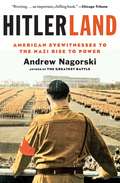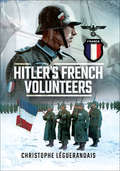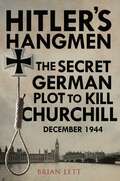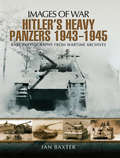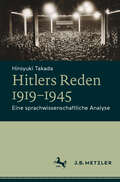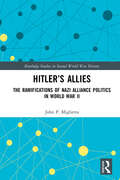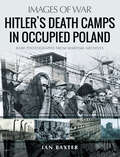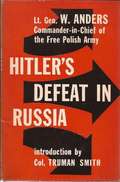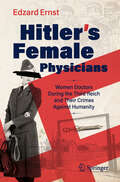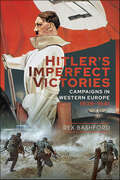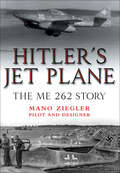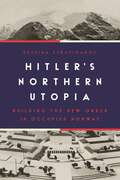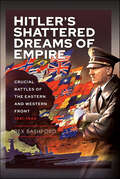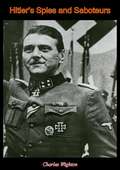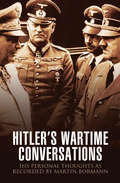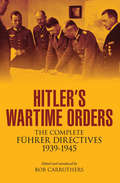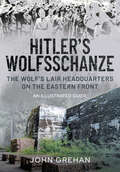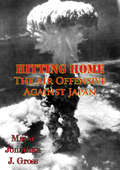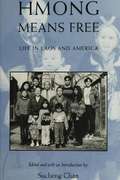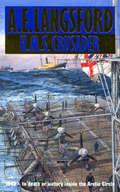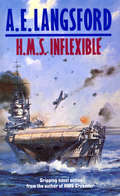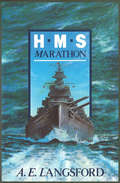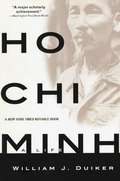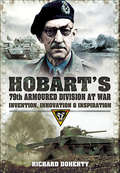- Table View
- List View
Hitlerland: American Eyewitnesses to the Nazi Rise to Power
by Andrew NagorskiHitler's rise to power, Germany's march to the abyss, as seen through the eyes of Americans--diplomats, military, expats, visiting authors, Olympic athletes--who watched horrified and up close. By tapping a rich vein of personal testimonies, Hitlerland offers a gripping narrative full of surprising twists--and a startlingly fresh perspective on this heavily dissected era. Some of the Americans in Weimar and then Hitler's Germany were merely casual observers, others deliberately blind; a few were Nazi apologists. But most slowly began to understand the horror of what was unfolding, even when they found it difficult to grasp the breadth of the catastrophe. Among the journalists, William Shirer, Edgar Mowrer, and Dorothy Thompson were increasingly alarmed. Consul General George Messersmith stood out among the American diplomats because of his passion and courage. Truman Smith, the first American official to meet Hitler, was an astute political observer and a remarkably resourceful military attaché. Historian William Dodd, whom FDR tapped as ambassador in Hitler's Berlin, left disillusioned; his daughter Martha scandalized the embassy with her procession of lovers from her initial infatuation with Nazis she took up with. She ended as a Soviet spy. On the scene were George Kennan, who would become famous as the architect of containment; Richard Helms, who rose to the top of the CIA; Howard K. Smith, who would coanchor the ABC Evening News. The list of prominent visitors included writers Sinclair Lewis and Thomas Wolfe, famed aviator Charles Lindbergh, the great athlete Jesse Owens, newspaper publisher William Randolph Hearst, and black sociologist and historian W.E.B. Dubois. Observing Hitler and his movement up close, the most perceptive of these Americans helped their reluctant countrymen begin to understand the nature of Nazi Germany as it ruthlessly eliminated political opponents, instilled hatred of Jews and anyone deemed a member of an inferior race, and readied its military and its people for a war for global domination. They helped prepare Americans for the years of struggle ahead.
Hitlers French Volunteers
by Christophe LeguérandaisFrom 1941 to 1945, a large number of foreign soldiers were incorporated into the ranks of the German army in order to compensate for the enormous losses suffered by the Wehrmacht, including thousands of French. Whether fighting against the Soviets on the Eastern Front, with the Afrika-Korps in Tunisia or fighting with the occupying army in France, these volunteers generally took the plunge to join the Germans with the authorization of their own government, even though there was never any 'formal link' to the Vichy regime.For the first time in the English language, this book provides details of the units' various insignias, along with rare and previously unpublished and personal photographs of the few surviving members interviewed by the author. As a result, a new vision of these collaborators emerges, allowing them to be regarded as adventurers or even nationalists. After all, despite being clothed in the enemy's uniform, the majority of these soldiers respected their oath of allegiance, often giving their lives in return.
Hitlers Hangmen: The Secret German Plot to Kill Churchill
by Brian LettBefore and after the outbreak of the Second World War there were sizeable Fascist groups active in Britain, working to overthrow the British government. Most of the Fascist leaders were interned in 1940 as soon as Churchill came to power, but were freed in the better times of 1944, all the more embittered and just as intent on installing a Fascist government and taking revenge on Churchill. By late 1944 there were hundreds of thousands of German prisoners of war in Britain, many of them in camps brutally dominated by the SS and other Nazi fanatics. When Hitler tried to restore Germany&’s position with his massive Battle of the Bulge offensive he gave orders for this to be supported by a break-out from all of the POW camps under Nazi control. Some of the escapers were to head for London to assassinate Churchill, with the help of the British Fascists. It was only by chance that the plot was foiled. This is the incredible, disturbing story of how close British Fascists came to impacting the outcome of the Second World War. It is also a comprehensive investigation of the break-out plot as it unfolded across Britain: how it came to fruition and how it was quashed, its repercussions and the many little-known stories of escape and recapture which took place throughout the country.
Hitlers Heavy Panzers, 1943–1945 (Images of War)
by Ian BaxterThis WWII pictorial history offers a fully illustrated and informative look at Nazi Germany&’s fearsome heavy tanks with rare wartime photos. With its authoritative text, detailed captions, and rare images, this volume chronicles the last desperate years of the Wehrmacht Panzerwaffe. Despite a worsening strategic situation both on the Eastern Front and in the West, Hitlers Panzers and their highly motivated crews showed superior tactical abilities and killing power—yet these armored battalions were not enough to alter the course of the war as the Allies closed in on Berlin. This superb book covers many variants to the Heavy Panzer, some well-known and others less so—including modified, up-armored and up-gunned tanks. Copious images of Tigers 1 and 11, Panzerjager, Panthers, Panzer 4s, StuG IV and III, Wespes, Hummels are provided as well as other fine examples of German engineering.
Hitlers Reden 1919–1945: Eine sprachwissenschaftliche Analyse
by Hiroyuki TakadaHitlers Reden spielten eine entscheidende Rolle im Prozess der nationalsozialistischen „Machtergreifung“ und der späteren Durchsetzung ihrer Politik. Das Buch untersucht die Gründe für die enorme Wirkung von Hitlers Auftritten, indem es die 1,7 Millionen Wörter, die die Reden umfassen, systematisch und in ihrer Entwicklung analysiert. Unter Einbeziehung der historischen und technikgeschichtlichen Hintergründe sowie detaillierten Beschreibungen von Hitlers Auftreten, seinen Gesten und rhetorischen Mitteln entsteht so eine Gesamtdarstellung von Hitlers Entwicklung als Redner – von den euphorisierenden Anfängen in den Bierkellern bis zu den kaum mehr beachteten Einlassungen am Ende des Krieges.
Hitler’s Allies: The Ramifications of Nazi Alliance Politics in World War II (Routledge Studies in Second World War History)
by John P. MigliettaThis book examines the significance of alliances in the international system, focusing on the dynamics between great and regional powers, and on the alliances Nazi Germany made during World War II, and their implications for Germany. It examines a variety of case studies and looks at how each of the respective states contributed to or weakened Nazi Germany’s warfighting capabilities. The cases cover the principal Axis members Italy and Japan, secondary Axis allies Hungary and Romania, as well as neutral states that had economic and military significance for Germany, namely Bulgaria, Iran, Spain, Sweden, Switzerland, Turkey, and Vichy France. Additional case studies include topics such as the German attempts to cultivate Arab nationalism, focusing on German involvement in the coup in Iraq against the pro-British government, and the wartime state of Croatia, whose creation was made possible by Germany, with the rivalry between Germany and Italy for control being a major focus. The book also includes a case study exploring the unique position of Finland among German allies as a democracy and how the country was essentially fighting a very different war from Nazi Germany. This will be of interest to students and academics with an interest in power dynamics in World War II, economic, political, strategic, and alliance theory, and scholarly debate on Nazism and Europe.
Hitler’s Death Camps in Occupied Poland: Rare Photographs from Wartime Archives (Images of War)
by Ian BaxterCovers the six principal extermination camps in Nazi occupied Poland; a sobering reminder of the horrors of the Holocaust.Nearly 80 years on, the concept and scale of the Nazis’ genocide program remains an indelible, nay almost unbelievable, stain on the human race. Yet it was a dreadful reality of which, as this graphic book demonstrates, all too much proof exists. Between 1941 and 1945 an estimated three and a half million Jews and an unknown number of others, including Soviet POWs and gypsies, perished in six camps built in Poland; Auschwitz-Birkenau, Belzec, Chelmno, Majdenak, Sobibor and Treblinka. Unpleasant as it may be, it does no harm for present generations to be reminded of man’s inhumanity to man, if only to ensure such atrocities will never be repeated. This book aims to do just this by tracing the history of the so called Final Solution and the building and operation of the Operation Reinhard camps built for the sole purpose of mass murder and genocide.
Hitler’s Defeat In Russia
by Lieutenant-General Władysław AndersTo both professional soldiers and historians, the causes of the German catastrophe in Eastern Europe in the years from 1941 to 1945 will ever remain an absorbing problem. Why did Hitler’s hitherto invincible Wehrmacht—which between September 1939 and June 1941 had knocked over like tenpins the far from negligible armies of Poland, France, and Yugoslavia, had driven three-hundred-odd thousand British from the continent in a campaign of a few brief weeks, and had spread the rule of Hitler’s Reich from Brest to Crete and from Arctic Narvik to the desert sands of Tripoli—why did this Wehrmacht come to a dead halt before Moscow within six months of launching its all-out assault on the Soviet Union? Why, once again in the autumn of 1942, did the Wehrmacht suffer such an overwhelming defeat at Stalingrad—after occupying nearly half of European Russia, reducing the Red armies to less than two and one half million men at the beginning of 1942, and planting the swastika on Mount Elbrus in the Caucasus, more than 1,000 miles from its advanced base in Poland?These are questions General Anders attempts to answer in the present analytical study of the Russo-German war—and, in my opinion, he succeeds to the full, with amazing clarity and unanswerable logic.-Foreword.
Hitler’s Female Physicians: Women Doctors During the Third Reich and Their Crimes Against Humanity
by Edzard ErnstThere have been many books about the doctors of the Third Reich and their atrocities. Most of these books neglect the contribution of women in the medical profession. In this book, they are the focus of attention. The first section of the book explains the background of the Third Reich in general and medicine during this period in particular. It addresses the situation of female doctors and why there were relatively few of them. It goes on to detail the forms of transgression that occurred under Nazi rule—involuntary sterilization, euthanasia, and mass murder of Jews and other groups considered undesirable. The second part of the book is a collection of 38 alphabetically arranged biographies of individual female doctors who participated in these activities. It reports on the actions they took and what happened to them after the war. The final chapter draws some conclusions, which can be briefly summarized as follows: 1) the female doctors' role remains under-researched, 2) generally speaking, female doctors were also guilty, but their transgressions generally less gruesome than those of their male colleagues, 3) many of the deeds of female doctors are nevertheless shocking.
Hitler’s French Literary Afterlives, 1945-2017
by Manuel BragançaThis book analyses the successive appearances of Adolf Hitler in French fiction between 1945 and 2017. It discusses why, unlike what has been observed in the US and in the UK, it has proven problematic for French novelists to write about Hitler in their numerous fictional explorations of the Second World War. It examines the literary and ethical challenges of including historical characters such as Hitler in fiction, and demonstrates how these challenges evolved over time as memories of the Second World War also evolved in France.
Hitler’s Imperfect Victories: Campaigns in Western Europe 1939–1941
by Rex BashfordA comprehensive analysis of Hitler’s role as the supreme military leader of the Third Reich across all the major campaigns. There have been many books on Adolf Hitler and specific military campaigns and battles during the time of the Third Reich. However, there has never been a comprehensive analysis of Hitler’s role as the supreme military leader of the Third Reich across all the major campaigns. He combined every senior position in government and the armed forces until he was at the same time Supreme Commander of the Armed Forces, Chancellor, Minister of War and Commander-in-Chief of the Army. He was involved in every aspect of the German war effort including new weapons development. How well did he perform these roles? He called himself a genius and was described as ”the greatest German military leader of all time” by one of his most senior military leaders – was he? What does the evidence show? This book analyses each of the Third Reich’s military campaigns paying special attention to Hitler’s role in them. The book is based entirely on the evidence of the most senior military personnel who were there at the time, from their contemporaneous diaries and subsequent writings. The sources used include the diaries and recollections of three Chiefs of the Army General Staff, Field-Marshals Rommel, von Rundstedt, von Bock, von Kliest, von Manstein, numerous other senior generals, Hitler’s military adjutants, ministers of his government and evidence from the Trial of the Major War Criminals at Nuremberg. Is there a consistent thread in this evidence? The first Volume is called Imperfect Victories and deals with the Polish, Scandinavian and French campaigns.
Hitler’s Jet Plane: The ME 262 Story
by Mano ZieglerThe first operational military jet in the world, towards the end of the Second World War the ME 262 was to be the German miracle weapon. Mano Ziegler was involved from its inception and contributed to the design, testing, and training and even served in it operationally. Could the ME 262 have broken the Allied supremacy in the air? Why did it take so long to come into service and why were hundreds of German pilots sacrificed in developing it? Why did the ME 262 prove not to be the unparalleled success claimed by Goering and why were German cities left dangerously exposed against Allied bombing campaigns? These are only some the important questions this new book answers.Mano Ziegler, born 7 June 1908, had a lifetime fascination with flight. At the age of eight, he wrote to Manfred Freiherr von Richthofen, the famous Red Baron, asking to be allowed to fly with him. Richthofen even replied, telling him, Yes, we'll fly together! When war broke out in 1939 he became a pilot in the Luftwaffe, and from 1943 until the war's end, he flew the Me 163.
Hitler’s Northern Utopia: Building the New Order in Occupied Norway
by Despina StratigakosThe fascinating untold story of how Nazi architects and planners envisioned and began to build a model “Aryan” society in Norway during World War IIBetween 1940 and 1945, German occupiers transformed Norway into a vast construction zone. This remarkable building campaign, largely unknown today, was designed to extend the Greater German Reich beyond the Arctic Circle and turn the Scandinavian country into a racial utopia. From ideal new cities to a scenic superhighway stretching from Berlin to northern Norway, plans to remake the country into a model “Aryan” society fired the imaginations of Hitler, his architect Albert Speer, and other Nazi leaders. In Hitler’s Northern Utopia, Despina Stratigakos provides the first major history of Nazi efforts to build a Nordic empire—one that they believed would improve their genetic stock and confirm their destiny as a new order of Vikings.Drawing on extraordinary unpublished diaries, photographs, and maps, as well as newspapers from the period, Hitler’s Northern Utopia tells the story of a broad range of completed and unrealized architectural and infrastructure projects far beyond the well-known German military defenses built on Norway’s Atlantic coast. These ventures included maternity centers, cultural and recreational facilities for German soldiers, and a plan to create quintessential National Socialist communities out of twenty-three towns damaged in the German invasion, an overhaul Norwegian architects were expected to lead. The most ambitious scheme—a German cultural capital and naval base—remained a closely guarded secret for fear of provoking Norwegian resistance.A gripping account of the rise of a Nazi landscape in occupied Norway, Hitler’s Northern Utopia reveals a haunting vision of what might have been—a world colonized under the swastika.
Hitler’s Shattered Dreams of Empire: Crucial Battles of the Eastern and Western Front 1941–1944
by Rex BashfordThere have been many books on Adolf Hitler and specific military campaigns and battles during the time of the Third Reich. However, there has never been a comprehensive analysis of Hitler’s role as the supreme military leader of the Third Reich across all the major campaigns. He combined every senior position in government and the armed forces until he was at the same time Supreme Commander of the Armed Forces, Chancellor, Minister of War and Commander-in-Chief of the Army. He was involved in every aspect of the German war effort including new weapons development. How well did he perform these roles? He called himself a genius and was described as “the greatest German military leader of all time” by one of his most senior military leaders – was he? What does the evidence show? This book analyzes each of the Third Reich’s military campaigns and the programs for the development of new weapons including the V1, V2 and the A bomb paying special attention to Hitler’s role in them. The book is based entirely on the evidence of the most senior military personnel who were there at the time, from their contemporaneous diaries and subsequent writings. The sources used include the diaries and recollections of three Chiefs of the Army General Staff, Field-Marshals Rommel, von Rundstedt, von Bock, von Kliest, von Manstein, numerous other senior generals, Hitler’s military adjutants, ministers of his government and evidence from the Trial of the Major War Criminals at Nuremberg. Is there a consistent thread in this evidence? Hitler's Shattered Dreams of Empire is the second of a three part in depth study and deals with Hitler’s influence on the crucial battles on the eastern front resulting from the Nazi invasion of the USSR in 1941 'Operation Barbarossa' together with the allied invasions of 'Festung Europa' and the Ardennes Offensive in 1944-45.
Hitler’s Spies and Saboteurs
by Charles Wighton Gunter PeisAt Nuremberg, in 1945, General Erwin von Lahousen-Vivremont, head of Abwehr II—the sabotage division of the German Armed Forces Secret Service—shocked the world with his revelations of Nazi war crimes. He exposed the activities of Göring, Ribbentrop, and other top-ranking Third Reich officials. But there was much more he did not tell!Here is the rest of his story-the top-secret details of Germany’s international espionage ring during World War II.Lahousen had kept a diary. In the United States, Britain, France and other countries, his agents—often citizens of these countries, for Lahousen believed Germans lacked the spontaneity that made for expert spies—carried out some of the war’s most daring missions.In his diary, Lahousen named names and described espionage activities in detail. He wrote of Hermann Lang in the United States, a German-American who provided the Nazis with blueprints of U.S. military machinery; of Robey Leibbrandt, the young African “Olympic Boxer Spy”; of beautiful Vera, bilingual mistress of an Abwehr agent; and many others. Their astounding stories, along with that of the master spy, Lahousen, appear documented and unabridged in these pages.No fictional spy novel can compare with the drama and excitement of the authentic espionage missions revealed here.“Full of fascinating and astounding tales”—Library Journal“Gripping…”—Springfield Republican“A painstaking and convincing record of the daily world of espionage…”—Saturday Review
Hitler’s Wartime Conversations: His Personal Thoughts as Recorded by Martin Bormann
by Bob CarruthersAfter dinner at the Wolfs Lair it was Hitlers custom to retire to his private quarters where Hitler and his entourage often listened to gramophone records of Beethoven symphonies, selections from Wagner while Hitler would hold forth with lengthy and rambling monologues touching on a wide variety of subjects. Hitler was invariably joined by Keitel and his two secretaries, also present was Martin Bormann who decided to commission a recording of Hitlers words for posterity.
Hitler’s Wartime Orders: The Complete Führer Directives, 1939–1945
by Bob CarruthersPresented here, in one collection, is the important historical record of Hitler’s war directives. From preparations for the invasion of Poland to his last desperate order to his troops on the Eastern Front, this unbroken edition provides a fascinating insight in to the proceedings of the Second World War and the mind of the man that launched the world into chaos. From initial optimism in 1939, to the disarray of later orders, it is fascinating to see how the events of the war were received and processed by the upper echelons of the Third Reich and how these reactions shaped future military policy. This unvarnished publication reveals the true nature of Adolf Hitler as a military commander and sheds light on the events of one of the world’s greatest tragedies. All the wartime orders has been typeset in a clear presentation format and presented chronologically.
Hitler’s Wolfsschanze: The Wolf’s Lair Headquarters on the Eastern Front – An Illustrated Guide
by John GrehanSet deep in the heart of the Masurian woods of northern Poland, in what was formally East Prussia, lies a vast complex of ruined bunkers and shelters that once constituted Hitler’s headquarters – the Wolfsschanze or Wolf’s Lair – for Germany’s attack upon the Soviet Union in 1941. Built in conditions of the utmost secrecy, the Wolfsschanze was surrounded by fences and guard posts, its paths and tracks were hidden, and buildings were camouflaged and concealed with artificial grass and trees planted on their flat roofs. As the war in Eastern Europe continued, so the Wolf’s Lair grew in scale and sophistication, until it’s 2.5 square miles incorporated more than eighty buildings including massive reinforced bunkers. It was also at the Wolfsschanze that Colonel von Stauffenberg almost killed Hitler in the summer of 1944. That building is still there, its roof sitting on its collapsed walls. With the aid of a unique collection of color photographs, the reader is guided around the Wolfsschanze as it appears today, with each building and its purpose identified. Laced with numerous personal accounts of the installation and of Hitler’s routines, supplemented with contemporary images, the Wolfsschanze is brought to life once more. The Wolfsschanze, however, was not the only military complex in this small part of the Eastern Front. Once Hitler has established his command centre at the Wolfsschanze, in effect the home of the Oberkommando der Wehrmacht (or military high command), the other branches of the German armed forces and civil authorities quickly followed suit. Just a few miles away, for example, the German Army built its own operational headquarters at Mauerwald – a complex which amounted to an even greater concentration of buildings, many of which remain intact and open to the public. Göring duly ordered that the Luftwaffe’s headquarters, codenamed Robinson, be built further out near the current Russian border, whilst Himmler’s SS headquarters at Hochwald and that for Hans Lammers’ Reich Chancellery were situated back nearer the Wolfsschanze. For the first time, these astonishing sites, five complexes from which the war on the Eastern Front was directed, are shown and described in one book, providing a comprehensive survey of the installations whose gigantic scale still evinces awe and wonder.
Hitting Home - The Air Offensive Against Japan [Illustrated Edition] (The U.S. Army Air Forces in World War II #3)
by Daniel L. HaulmanIncludes 20 illustrationsThe strategic bombardment of Japan during World War II remains one of the most controversial subjects of military history because it involved the first and only use of atomic weapons in war. It also raised the question of whether strategic bombing alone can win wars, a question that dominated U.S. Air Force thinking for a generation. Without question, the strategic bombing of Japan contributed very heavily to the Japanese decision to surrender. The United States and her allies did not have to invade the home islands, an invasion that would have cost many thousands of lives on both sides.This pamphlet traces the development of the bombing of the Japanese home islands, from the modest but dramatic Doolittle raid on Tokyo in April 1942, through the effort to bomb from bases in China that were supplied by airlift over the Himalayas, to the huge 500-plane raids from the Marianas in the Pacific. The campaign changed from precision daylight bombing to night incendiary bombing of Japanese cities and ultimately to the use of atomic bombs against Hiroshima and Nagasaki. The story covers the debut of the spectacular B-29 aircraft--in many ways the most awesome weapon of World War II-- and its use not only as a bomber but also as a mine-layer.Hitting Home is the sequel to High Road to Tokyo Bay, a pamphlet by the same author that concentrated on Army Air Forces' tactical operations in Asia and the Pacific areas during World War II. Taken together, they provide an overview of U.S. Army Air Forces' operations, tactical and strategic, against Japan. The U.S. air offensive against Japan is the central story of the Pacific war--a drama of human courage and sacrifice and of a unique partnership among modern air, sea, and land forces.
Hmong Means Free: Life in Laos and America
by Sucheng ChanThis collection of evocative personal testimonies by three generations of Hmong refugees is the first to describe their lives in Laos as slash-and-burn farmers, as refugees after a Communist government came to power in 1975, and as immigrants in the United States. Reflecting on the homes left behind, their narratives chronicle the difficulties of forging a new identity. From Jou Yee Xiongs Life Story: ""I stopped teaching my sons many of the Hmong ways because I felt my ancestors and I had suffered enough already. I thought that teaching my children the old ways would only place a burden on them. ""From Ka Pao Xiongs (Jou Yee Xiongs son) Life Story: ""It has been very difficult for us to adapt because we had no professions or trades and we suffered from culture shock. Here in America, both the husband and wife must work simultaneously to earn enough money to live on. Many of our children are ignorant of the Hmong way of life. . . . Even the old people are forgetting about their life in Laos, as they enjoy the prosperity and good life in America. ""From Xang Mao Xiongs Life Story: ""When the Communists took over Laos and General Vang Pao fled with his family, we, too, decided to leave. Not only my family, but thousands of Hmong tried to flee. I rented a car for thirty thousand Laotian dollars, and it took us to Nasu. . . . We felt compelled to leave because many of us had been connected to the CIA. . . . Thousands of Hmong were traveling on foot. Along the way, many of them were shot and killed by Communist soldiers. We witnessed a bloody massacre of civilians. ""From Vue Vangs Life Story: ""Life was so hard in the Thai refugee] camp that when we found out we could go to the United States, we did not hesitate to grasp the chance. We knew that were we to remain in the camp, there would be no hope for a better future. We would not be able to offer our children anything better than a life of perpetual poverty and anguish. ""
Hms Crusader
by A E LangsfordDeath by fire - Death by ice. These were the twin threats confronting the seamen on the North Atlantic convoys: fire from the Luftwaffe's bombs, and from the torpedoes of the lurking U-Boats: ice in the deadly cold waters that could kill in three minutes, five minutes at most.Between these two hells lived another threat: the slow paralyzing hand of fear.
Hms Inflexible: The war in the Pacific is reaching its climax…
by A E Langsford1945. The battle against Japan in the Pacific is reaching its climax. One way or another, Inflexible will be Captain Thurston's last command of the war.Captain Thurston VC is a navy man to his bones. Offered a cushy office job to see out the last months of the war, he resists: instead he's handed command of HMS Inflexible, a proud and powerful aircraft carrier.It is no easy task. The overwhelming determination of the Japanese fighters and the cruel weather conditions make Thurston's command fraught with difficulties, but the struggle to provide air support for the US and Commonwealth troops must continue.Home is on the other side of the world, barely a reality, and Thurston finds that he is striving to do the right thing, not only as the Captain of the Inflexible but also in his private life. For a while he and his men are under daily attack from a deadly enemy, Thurston is plagued by feelings of guilt and remorse for the woman he has left behind.A. E. Langford's compelling naval adventure is an evocative account of life at sea during one of the most perilous and hard-fought battles of this century.
Hms Marathon
by A E Langsford1942: The Mediterranean. The war at sea is at its most intense. Operation Stonehenge gets under way - a convoy laden with desperately needed fuel, food and ammunition for the besieged island of Malta sets sail. Captain Robert Thurston commands the cruiser HMS Marathon, one of the escort vessels on this Malta run. Thurston is a career officer with a record of conspicuous gallantry under fire, from Jutland to the North Atlantic convoys. But he is also a man under stress - in the last three years he has seen one ship go to the bottom, leaving pitifully few survivors; he has seen his closest friends and shipmates killed and maimed; he has carried the impossibly heavy burden of responsibility for his men's welfare in the bloody destruction of war at sea.And soon another cause for concern is added to his worries - Marathon is crippled by enemy action and forced to limp towards Alexandria, a constant target for attack by sea and air, vulnerable to the weather and to the enemy alike. Men and machines are stretched to their limit - but the most deadly threat to Thurston's own life and career is yet to be faced.
Ho Chi Minh: A Life
by William J. DuikerTo grasp the complicated causes and consequences of the Vietnam War, one must understand the extraordinary life of Ho Chi Minh, the man generally recognized as the father of modern Vietnam. Duiker provides startling insights into Ho's true motivation, as well as into the Soviet and Chinese roles in the Vietnam War.
Hobart's 79th Armoured Division at War: Invention, Innovation & Inspiration
by Richard DohertyThis WWII history chronicles the remarkable career of a brilliant British Army commander and the innovative armored vehicles he created. Joining the Royal Tank Corps in 1923, Major-General Percy Hobart quickly established himself as one of the foremost thinkers on armored warfare. By 1938 he was GOC Mobile Division, later 7th Armored Division, in Egypt. He was also known for not suffering fools—a tendency that got him briefly relieved of his command. But during World War II, Winston Churchill called Hobart back to Army service with orders to train the now-legendary 11th Armored Division. He was then tasked with designing specialist armored fighting vehicles capable of breeching the Atlantic Wall. Known as Hobart's Funnies, these unique vehicles included mine-clearing tanks, bridge-carrying tanks, flamethrowers, swimming tanks and amphibious assault vehicles. Operated by Hobart&’s 79th Armored Division, they played a major part in the D-Day landings and the subsequent European campaigns. Hobart's skills played a significant part in the final Allied victory, and the specialized funnies he introduced to modern warfare have since been adopted by all armies all over the world. Drawing on official records and personal recollections, historian Richard Doherty tells the incredible story of Percy Hobart and his 79th Armored Division.
